Related Research Articles
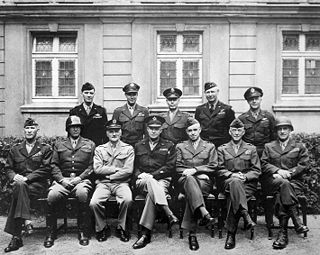
The European Theater of Operations, United States Army (ETOUSA) was a theater of Operations responsible for directing United States Army operations throughout the European theatre of World War II, from 1942 to 1945. It commanded Army Ground Forces (AGF), United States Army Air Forces (USAAF), and Army Service Forces (ASF) operations north of Italy and the Mediterranean coast. It was bordered to the south by the North African Theater of Operations, United States Army (NATOUSA), which later became the Mediterranean Theater of Operations, United States Army (MTOUSA).
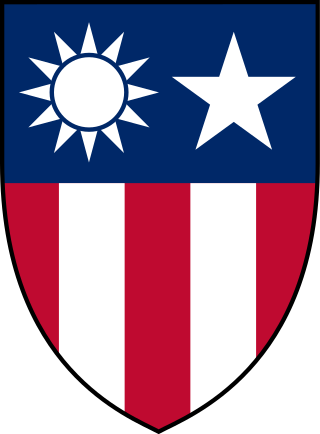
China Burma India Theater (CBI) was the United States military designation during World War II for the China and Southeast Asian or India–Burma (IBT) theaters. Operational command of Allied forces in the CBI was officially the responsibility of the Supreme Commanders for South East Asia or China. In practice, U.S. forces were usually overseen by General Joseph Stilwell, the Deputy Allied Commander in China; the term "CBI" was significant in logistical, material and personnel matters; it was and is commonly used within the US for these theaters.
The Mediterranean Theater of Operations, United States Army (MTOUSA), originally called the North African Theater of Operations, United States Army (NATOUSA), was a military formation of the United States Army that supervised all U.S. Army forces which fought in North Africa and Italy during World War II.

The History of the Great War Based on Official Documents by Direction of the Committee of Imperial Defence is a series of 109 volumes, concerning the war effort of the British state during the First World War. It was produced by the Historical Section of the Committee of Imperial Defence from 1915 to 1949; after 1919 Brigadier-General Sir James Edmonds was Director. Edmonds wrote many of the army volumes and influenced the choice of historians for the navy, air force, medical and veterinary volumes. Work had begun on the series in 1915 and in 1920, the first volumes of Naval Operations and Seaborne Trade, were published. The first "army" publication, Military Operations: France and Belgium 1914 Part I and a separate map case were published in 1922 and the final volume, The Occupation of Constantinople was published in 2010.
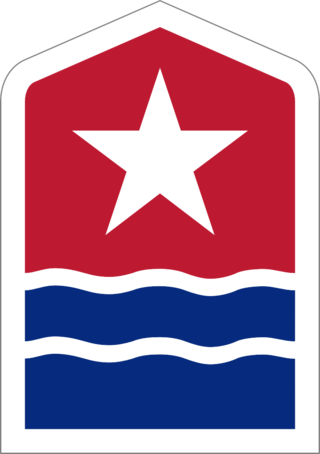
United States Army Forces in the Middle East(USAFIME) was a unified United States Army command during World War II established in August, 1942 by order of General George C. Marshall, the Chief of Staff of the United States Army, to oversee the Egypt-Libya campaign.

Panzer Battles is the English language title of Friedrich von Mellenthin's memoirs of his service as a staff officer in the Panzerwaffe of the German Army during World War II.
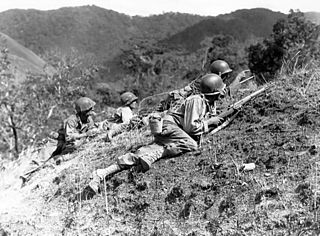
The Battle of Luzon was a land battle of the Pacific Theater of Operations of World War II by the Allied forces of the U.S., its colony the Philippines, and allies against forces of the Empire of Japan. The battle resulted in a U.S. and Filipino victory. The Allies had taken control of all strategically and economically important locations of Luzon by March 1945, although pockets of Japanese resistance held out in the mountains until the unconditional surrender of Japan. While not the highest in U.S. casualties, it is the highest net casualty battle U.S. forces fought in World War II, with 192,000 to 217,000 Japanese combatants dead, 8,000 American combatants killed, and over 150,000 Filipinos, overwhelmingly civilians who were murdered by Japanese forces, mainly during the Manila massacre of February 1945.
Marvel Masterworks is an American collection of hardcover and trade paperback comic book reprints published by Marvel Comics, with the main goal of republishing classic Marvel Comics storylines in a hardcover, premium edition, often with restored artwork and better graphical quality when compared to other Marvel collected editions. The collection started in 1987, with volumes reprinting the issues of The Amazing Spider-Man, The Fantastic Four, The X-Men, and The Avengers. The Masterworks line has expanded from such reprints of the 1960s period that fans and historians call the Silver Age of Comic Books to include the 1930s–1940s Golden Age; comics of Marvel's 1950s pre-Code forerunner, Atlas Comics; and even some reprints from the 1970s period called the Bronze Age of Comic Books.

Australia in the War of 1939–1945 is a 22-volume official history series covering Australian involvement in the Second World War. The series was published by the Australian War Memorial between 1952 and 1977, most of the volumes being edited by Gavin Long, who also wrote three volumes and the summary volume The Six Year War.
The Official History of the Canadian Army in the Second World War was a three volume set of books, based on the wartime work of the Historical Section of the General Staff. The Canadian Army had a dedicated set of officers in the Second World War who studied and recorded various facets of wartime history for posterity.

The Japanese occupation of Kiska took place between 6 June 1942 and 28 July 1943 during the Aleutian Islands campaign of the American Theater and the Pacific Theater of World War II. The Japanese occupied Kiska and nearby Attu Island in order to protect the northern flank of the Japanese Empire.

The Senshi Sōsho, also called the Kōkan Senshi (公刊戦史), is the official military history of Imperial Japan's involvement in the Pacific War from 1937 to 1945. The task of compiling the official account of the Japanese involvement in World War II began in October 1955 with the opening of the War History Office. Its main function was to serve as educational research material for the Self-Defense Forces. The office was led by Colonel Nishiura Susumu, a senior official in the War Ministry during the war. The publisher was Asagumo Shimbunsha.

The United States Army Air Forces was the major land-based aerial warfare service component of the United States Army and de facto aerial warfare service branch of the United States during and immediately after World War II (1941–1947). It was created on 20 June 1941 as successor to the previous United States Army Air Corps and is the direct predecessor of the United States Air Force, today one of the six armed forces of the United States. The AAF was a component of the United States Army, which on 2 March 1942 was divided functionally by executive order into three autonomous forces: the Army Ground Forces, the United States Army Services of Supply, and the Army Air Forces. Each of these forces had a commanding general who reported directly to the Army Chief of Staff.

The 406th Air Expeditionary Group is the operational flying component of the 406th Air Expeditionary Wing. It is a provisional unit assigned to the United States Air Forces in Europe.
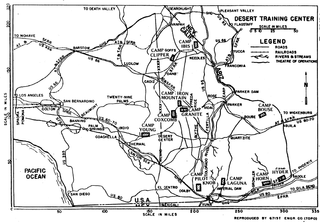
The Desert Training Center (DTC), also known as California–Arizona Maneuver Area (CAMA), was a World War II training facility established in the Mojave Desert and Sonoran Desert, largely in Southern California and Western Arizona in 1942.

The 181st Infantry Regiment shares the distinction of being the oldest combat regiment currently organized in the United States Army. It is one of several National Guard units with colonial roots and campaign credit for the War of 1812. The regiment traces its history to 13 December 1636, when it was one of four colonial regiments of foot of the British Crown in Massachusetts. It later served in the Continental Army during the American Revolution, with Union forces in the American Civil War, and as a federalized Massachusetts National Guard regiment with the U.S. Army during War with Spain, Mexican Border Campaign, World War I, and World War II. In 2006 Company A (Agawam) of the battalion deployed as a member of KFOR8 to Kosovo in support of Operation Joint Enterprise. Most recently the 1st Battalion, 181st Infantry has served in Iraq, in New Orleans following Hurricane Katrina, and in Afghanistan. The only active element of the regiment is the 1st Battalion, 181st Infantry Regiment, which returned from a year of service in Afghanistan in July 2011. The 1st Battalion was mobilized in March 2017 for one year of service with the Multinational Force & Observers in the Sinai Peninsula of Egypt. Currently, the 1st Battalion is a part of the 44th Infantry Brigade Combat Team, a major formation of the New Jersey National Guard. It was reflagged from the 50th Infantry Brigade Combat Team in 2017.
The Civil War book series chronicles in great detail the American Civil War. Published by Time Life the series was simultaneously released in the US and Canada between 1983 and 1987, with subsequent identical reprints in the late 1980s - early 1990s following suit for foreign, though untranslated, dissemination as well. Some titles focused on a specific topic, such as the blockade, and spies, but most volumes concentrated on the battles and campaigns, presented in chronological order.
History of U.S. Marine Corps Operations in World War II is the official history of the Corps during the war. Its five volumes were published beginning in 1958.

Brigadier Cyril Nelson Barclay CBE DSO was a British soldier, editor, and author. He served with the Cameronians in two World Wars, rising to the rank of brigadier, and after retiring from the army in 1946 was editor of The Army Quarterly and Defence Journal from 1950 to 1966, co-editor of Brassey's Annual: The Armed Forces Year Book from 1950 to 1969, and contributed articles to encyclopedias and periodicals.
References
- ↑ Adamczyk, Richard D. (1992). United States Army in World War II: Reader's Guide. Washington, DC: Center of Military History. pp. 173. ISBN 978-0160378171. OCLC 813914147.
CMH Pub 11-9
- ↑ "U.S. Army in World War II Series". army.mil. U.S. Army Center of Military History. Retrieved 4 September 2016.